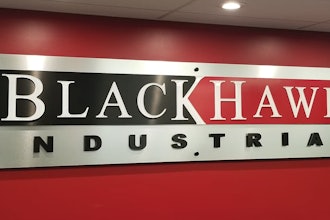|
"No "one size fits all" blueprint exists to universally chart the course of sustainability programs." - Bart G. Bartholomew |
A: As the concept of sustainability gains traction in the industry, many manufacturers will narrowly correlate sustainability with "going green" and the subsequent development and implementation of environmentally friendly programs.
While positive impact on the environment is certainly a primary objective of any sustainability effort, the influence of a successful sustainability program will extend much further, and can present newfound opportunities, not simply relating to environmental goals.
Sustainability is defined by the International Trade Association (ITA) as "the creation of manufactured products using processes that are non-polluting, conserve energy, and safe for employees, communities, and consumers."
Proactive sustainability programs will inherently provide opportunities to support strategic decision-making, sharpen the competitive edge, and safeguard natural resources.
Specific and highly practical benefits can further be realized in terms of reduced operating costs, increased productivity and profitability, measurable energy savings and reduced carbon dioxide (CO2) emissions, improved waste and chemical management, enhanced equipment reliability, and better health and safety working conditions.
For the maintenance function alone, the road to sustainability can lead to more effective strategic directions and more efficient approaches.
In our case, sustainability involves developing and offering new environmentally sound, energy-efficient products and services, as well as introducing effective energy conservation programs. We further encourage employees to take individual responsibility for active contributions to sustainability at work and in their private lives.
Our commitment extends to suppliers, too, with the message that a positive track record for sustainability makes a big difference to us.
Q: How has SKF organized its own sustainability efforts for implementation?
A: We have purposely structured our sustainability program worldwide under four cornerstones founded upon the theme of "SKF Cares:" Business Care, Environment Care, Employee Care, and Community Care.
In Business Care, a key mission is to partner with customers to develop environmentally and economically sound solutions for industry challenges. Under Environment Care, our daily job is to minimize negative impact, exceed goals, and set a shining example. Our Employee Care approach seeks to encourage pride, loyalty, dedication, and full potential. For the global Community Care, our mandate is to serve as a "good neighbor" around the world.
Of course, no "one size fits all" blueprint exists to universally chart the course of sustainability programs. How a particular sustainability effort is devised and implemented will depend on factors ranging from an organization's culture to its capabilities and ongoing commitment.
Q: How does the SKF BeyondZero™ initiative fit within the environmental objectives of sustainability, and how has the rollout of the concept fared so far?
A: BeyondZero™ was launched in 2005 with the mission to achieve an overall positive net impact on the environment above and beyond "reductions." The aim (for us and our customers) is to reduce our "footprint," and add even more positive contributions. Our toolbox has been equipped with specialized technologies, products, and services for the job.
Among noteworthy examples where sustainability and BeyondZero principles have been intertwined, a customer facility reduced lubricant consumption for plant machinery by 18 percent and, in turn, reduced the time and money previously spent for associated lubrication-related maintenance. Even more dramatically, overall production eventually rose by 30 percent. This was accomplished by repositioning equipment maintenance practices to reliability-centered paradigms driven by condition monitoring technology. Recurring and costly unscheduled downtime for machinery virtually vanished.
In another operation, simply by changing maintenance practices, four percent in energy reduction opportunities were identified for a plant's compressors.
Another customer installed a heat-recovery system on a factory's roof to recover excess heat from the exhaust air heating the building. This has reduced CO2 emissions by about 380 tons a year, and amounted to millions of kilowatt-hours (kWh) in savings by capping the traditional reliance on expensive purchased energy.
For another manufacturer, energy efficiency increased due to a variety of sustainability-oriented projects, including the introduction of frequency-controlled pumps, heat recovery from the production of compressed air, installation of new lighting in factories and warehouses, and roof insulation.
SKF set a goal in 2002 to reduce our collective CO2 emissions worldwide by 10 percent in 2007. This target was achieved well ahead of schedule in 2005 and new targets have been posted (and so far met) every year.
Q: With the industrial market a high consumer of energy, what are some of the newer technologies available to help promote energy efficiency, and where can these be applied in a plant operation?
A: The targets of opportunity for sustainability improvements, especially relating to energy efficiency, can be found in virtually every piece of equipment and among all applications and processes within industry.
For example, rolling bearings in rotating equipment traditionally function to reduce friction with rolling elements, support shaft loads, and provide system rigidity and shaft location. From the perspective of sustainability, significant improvements in design and engineering have enabled bearings to contribute so much more, whether in electric motors, gearboxes, fans, pumps, compressors, tools, robotics, or other equipment. In particular, bearings offering the capability to work with less energy have moved from the drawing board to production.
By their very nature, rolling bearings reduce the amount of energy that machinery requires. Even though less than one percent of the energy consumption in motor-driven equipment is associated with the bearing, savings in small amounts can add up, especially over time.
A new family of SKF energy-efficient bearings benefits from proprietary optimized internal geometry, unique polymer cage design, innovative manufacturing techniques, and high-performance grease to exhibit significantly less friction, or friction loss, compared with conventional bearing types. Their introduction can reduce friction loss by at least 30 percent, depending on bearing size and application conditions, which ultimately yields reductions in power loss and energy consumption.
Offering a completely different approach in supporting rotating equipment, magnetic bearings incorporate electromagnet technology and, without rolling elements, these represent a "non-contacting technology." In sustainability terms, this translates to negligible friction loss (consuming less energy) and absence of lubrication (eliminating a need for oil replenishment and disposal). These bearings ideally suit processes sensitive to contamination, such as the vacuum chambers for semiconductor manufacturing, and also can be applied to turbo compressors, machine tools, and other equipment where their operating principle would prove advantageous.
Another dominant trend pertaining to sustainability is a transition from fluid-dependent hydraulics and cumbersome pneumatics to cleaner, more environmentally friendly, and simplified electromechanical actuation systems. "Mechatronics" technology is at the forefront of solutions.
The infrastructure required for hydraulic systems necessitates a hydraulic unit, tank for oil, and filter systems, among other components; pneumatic-driven systems must rely upon air compressors, compressed air filters, and filter systems. In contrast, mechatronic systems require only power and control wires to perform.
Mechatronics presents motion and control in one package integrating mechanical and electronic technologies with application-specific software. Compared with hydraulic or pneumatic systems, mechatronics can make the grade for sustainability where motion will come into play, such as robotics applications.
Q: What tips would you give manufacturers as basic first steps in starting a sustainability initiative?
A: A top-to-bottom energy and environment analysis typically serves as a starting point. Such an analysis can identify areas of high energy consumption, and be engaged to evaluate chemical treatments, lubrication use, and other operating processes to determine environmental risk. Then, improvements linked to opportunities can be introduced, based on remedial action recommendations. Analyses additionally provide benchmarking data for arriving at realistic objectives and measuring subsequent results, based on established goals and targets.
Practices aimed at improving and enhancing the reliability and efficiency of assets can pay big dividends in striving toward sustainability success. Regularly monitored and well-maintained equipment can save energy, increase uptime, drive profitability, and advance core sustainability objectives.
Data is "king" for documenting and quantifying sustainability efforts and should be managed effectively. Customized web-based EHS (environmental, health, and safety) information management systems offer solutions to electronically automate key EHS functions, including sustainability metrics. This can drastically reduce time and money usually spent in collecting, analyzing, re-formatting, and preparing data. Capabilities expand with live CO2 footprint tracking and performance tracking and measurement.
Above all, employees organization-wide should be encouraged in their efforts to become active partners on this road to sustainability, because we all have a stake in the ultimate outcome.






















